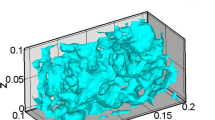Abstract
Non-combustible ash can be deposited on channel walls through the full length of a diesel particulate filter (DPF). This type of ash can affect the exhaust condition and heat transfer process during the periodical soot regeneration of DPF. A model of soot regeneration is established in this paper to describe the effects of ash deposits on exhaust condition and heat transfer. Mass, momentum, and energy balances are considered for the multiphase system of gas, soot, and wall. The good agreement with experimental data confirms that the model is able to describe the processes. The axial patterns of wall temperature and soot regeneration rate during DPF regeneration are investigated by numerical simulation. Results indicate that the deposited ash layer reduces the exhaust flow rate and increases the heat conduction resistance during DPF regeneration, thus leading to high wall temperature and soot oxidation rate. When 5 g/L of ash is deposited, the complete oxidation of soot can be achieved 90 s faster with a 60 ∘C increase in wall temperature. The gain on soot oxidation rate increases with increasing amounts of deposited ash and reaches a plateau when the deposited ash approaches 15 g/L. Owing to the sintering and melting of ash when the temperature reaches 900 ∘C and the consequent uncontrolled regeneration, the soot carrying capacity should be identified based on the amount of deposited ash within DPF.
Similar content being viewed by others
References
Chen, K., Martirosyan, K.S., Luss, D.: Transient temperature rise during regeneration of diesel particulate filters. Chem. Eng. J. 176–177, 144–150 (2011)
Peck, R., Becker, C.: Experimental investigations and dynamic simulation of diesel particulate filter systems. Chem. Eng. Technol. 32(8), 1411–1422 (2009)
Tsuneyoshi, K., Yamamoto, K.: A study on the cell structure and the performances of wall-flow diesel particulate filter. Energy 48, 492–499 (2012)
Sappok, A., Wong, V.W.: Ash Effects on Diesel Particulate Filter Pressure Drop Sensitivity to Soot and Implications for Regeneration Frequency and DPF Control, SAE Paper, 2010-01-0811
Ishizawa, T., Yamane, H., Satoh, H., Sekiguchi, K., Arai, M., Yoshimoto, N., Inoue, T.: Investigation into Ash Loading and Its Relationship to DPF Regeneration Method, SAE Paper, 2009-01-2882
Liati, A., Eggenschwiler, D.P., Gubler, E.M., Schreiber, D., Aguirre, M.: Investigation of diesel ash particulate matter: a scanning electron microscope and transmission electron microscope study. Atmos. Environ. 49, 391–402 (2012)
Liati, A., Eggenschwiler, D.P.: Characterization of particulate matter deposited in diesel particulate filters: visual and analytical approach in macro-, micro- and nano- scales. Combust. Flame 157, 1658–1670 (2010)
Sutton, M., Britton, N., Otterholm, B., Tengstrom, P., Frennfelt, C., Walker, A., Murray, I.: Investigations into Lubricant Blocking of Diesel Particulate Filters, SAE Paper, 2004-01-3013
Manni, M., Pedicillo, A., Bazzano, F.: A Study of Lubricating Oil Impact on Diesel Particulate Filters by Means of Accelerated Engine Tests, SAE Paper, 2006-01-3416
Sappok, A., Santiago, M., Vianna, T., Wong, V.W.: Characteristics and Effects of Ash Accumulation on Diesel Particulate Filter Performance: Rapidly Aged and Field Aged Results, SAE Paper, 2009-01-1086
McGeehan, J., Yeh, S., Rutherford, J., Couch, M.: Analysis of DPF Incombustible Materials from Volvo Trucks Using DPF-SCR-Urea With API CJ-4 and API CI-4 PLUS Oils, SAE Paper, 2009-01-1781
Sappok, A.G., Wong, V.W.: Detailed Chemical and Physical Characterization of Ash Species in Diesel Exhaust Entering Aftertreatment Systems, SAE Technical Paper, 2007-01-0318
Sappok, A., Beauboeuf, D., Wong, V.W.: A Novel Accelerated Aging System to Study Lubricant Additive Effects on Diesel Aftertreatment System Degradation, SAE Paper, 2008-01-1549
Mc Geehan, J., Yeh, S., Couch, M., Hinz, A., Otterholm, B., Walker, A., Blakeman, P.: On The Road to 2010 Emissions: Field Test Results and Analysis with DPF-SCR System and Ultra-Low-Sulfur Diesel Fuel, SAE Paper, 2005-01-3716
Kimura, K., Lynskey, M., Corrigan, E., Hickmann, D., Wang, J., Fang, H., Chatterjee, S.: Real-World Study of Diesel Particulate Filter Ash Accumulation in Heavy-Duty Diesel Trucks, SAE Paper, 2006-01-3257
Konstandopoulos, A., Zarvalis, D., Kladopoulou, E., Dolios, I.: A Multi-Reactor Assembly for Screening of Diesel Particulate Filters, SAE Paper, 2006-01-0874
Manni, M., Pedicillo, A., Bazzano, F.: A Study of Lubricating Oil Impact on Diesel Particulate Filters by Means of Accelerated Engine Tests, SAE Paper, 2006- 01-3416
Zhan, R., Eakle, S., Spreen, K.: Validation Method for Diesel Particulate Filter Durability, SAE Paper, 2007-01-4086
Zhan, R., Huang, Y.Q., Magdi, K.: Methodologies to Control DPF Uncontrolled Regeneration, SAE Paper, 2006-01-1090
Haralampous, O.C., Koltsakis, G.C., Samaras, Z.: Partial regenerations in diesel particulate filters, SAE Paper, 2003-01-1881
Bissett, E.J.: Mathematical model of the thermal regeneration of a wall-flow monolith diesel particulate filter. Chem. Eng. Sci. 39(7–8), 1232–1244 (1984)
Haralampous, O.C., Koltsakis, G.C.: Intra-layer temperature gradients during regeneration of diesel particulate filters. Chem. Eng. Sci. 57(8), 2345–2355 (2002)
Haralampous, O.C., Koltsakis, G.C., Samaras, Z.: Partial regenerations in diesel particulate filters. SAE Paper, 2003-01-1881
Lee, S.J., Jeong, S.J., Kim, W.S.: Numerical design of the diesel particulate filter for optimum thermal performances during regeneration. Appl. Energy 86(8), 1124–1135 (2009)
Yu, M.T., Luss, D., Balakotaiah, V.: Analysis of flow distribution and heat transfer in a diesel particulate filter. Chem. Eng. J. 226(4), 68–78 (2013)
Yu, M.T., Luss, D., Balakotaiah, V.: Analysis of ignition in a diesel particulate filter. Catal. Today 216(4), 158–168 (2013)
Galindo, J., Serrano, J.R., Piqueras, P., Afonso, O.G.: Heat transfer modelling in honeycomb wall-flow diesel particulate filters. Energy 43(4), 201–213 (2012)
Koltsakis, G., Stamatelos, A.: Modeling thermal regeneration of Wall-Flow diesel particulate traps. Aiche J. 42(6), 1662–1672 (1996)
Miyairi, Y., Miwa, S., Abe, F., Xu, Z., Nakasuji, Y.: Numerical study on forced regeneration of wall-flow diesel particulate filters. SAE paper, 2001-01-0912
Author information
Authors and Affiliations
Corresponding author
Rights and permissions
About this article
Cite this article
Chen, T., Wu, Z., Gong, J. et al. Numerical Simulation of Diesel Particulate Filter Regeneration Considering Ash Deposit. Flow Turbulence Combust 97, 849–864 (2016). https://doi.org/10.1007/s10494-016-9717-6
Received:
Accepted:
Published:
Issue Date:
DOI: https://doi.org/10.1007/s10494-016-9717-6




